Edgar Rice Burroughs’s Pellucidar Saga: Tarzan at the Earth’s Core
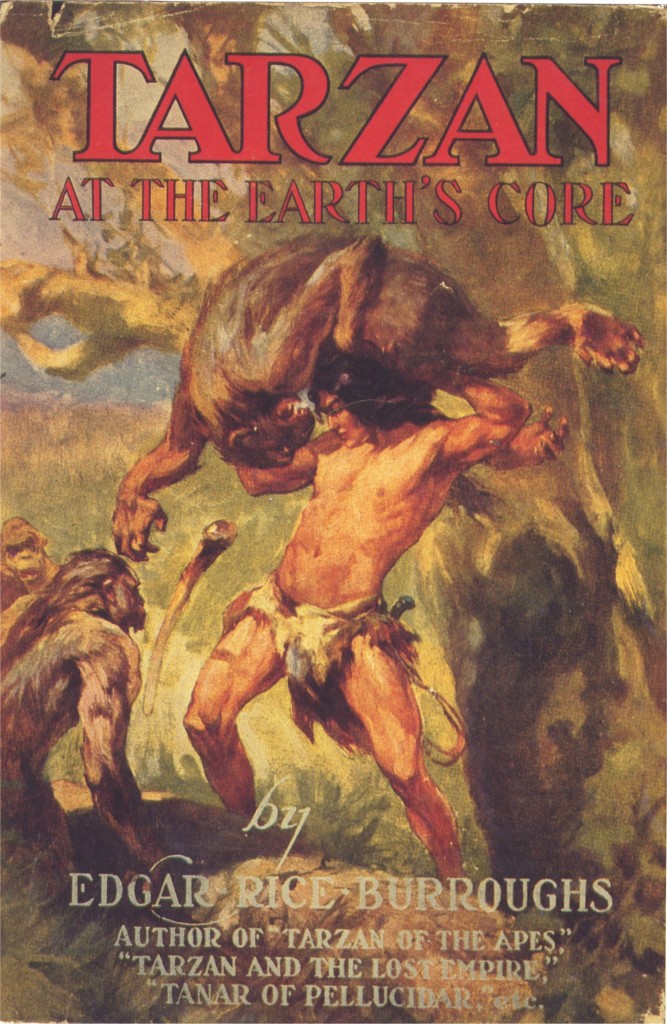 You’ll believe a Stegosaurus can fly!
You’ll believe a Stegosaurus can fly!
In the time I’ve written about Edgar Rice Burroughs for Black Gate, only once have I examined one of his Tarzan books. That was eight years ago. This lack of Tarzan representation isn’t because I dislike the character. A number of the early Tarzan adventures rate among my favorite Burroughs novels, and I’ll defend Tarzan of the Apes as one of the twentieth century’s Great Books. But since there’s more information available about Tarzan than any other Burroughs series, my literary adventuring was more interesting when it stayed in hinterlands of ERBiana.
However, it’s a thrill to have the ape-man swing in through the side door during one of my series retrospectives. Let’s welcome Tarzan onto the stage of Pellucidar. Ladies and gentlemen, boys and girls, Sagoths of all ages … it’s crossover time!
Our Saga: Beneath our feet lies a realm beyond the most vivid daydreams of the fantastic … Pellucidar. A subterranean world formed along the concave curve inside the earth’s crust, surrounding an eternally stationary sun that eliminates the concept of time. A land of savage humanoids, fierce beasts, and reptilian overlords, Pellucidar is the weird stage for adventurers from the topside layer — including a certain Lord Greystoke. The series consists of six novels, one which crosses over with the Tarzan series, plus a volume of linked novellas, published between 1914 and 1963.
Today’s Installment: Tarzan at the Earth’s Core (1929–30)
Previous Installments: At the Earth’s Core (1914), Pellucidar (1915), Tanar of Pellucidar (1929)
The Backstory
Although most of Edgar Rice Burroughs’s novels occur in the same universe, linked through the author’s fictional surrogate version of himself, Tarzan at the Earth’s Core is the only point where a character from one series leaps to another as the protagonist. It’s the fourth Pellucidar novel and the thirteenth Tarzan novel — full crossover achieved for the first and last time in the ERB canon.
“Tarzan and Pellucidar” — a title Burroughs didn’t feel enthusiastic about — reached Blue Book’s office in March 1929. Burroughs was paid $8,000 for the work, which he complained was less than other authors with similar sales figures were receiving. He suggested the story’s true market value was a whopping $60,000, which is a hair under $900,000 in 2017 currency. A similar complaint regarding royalties to publisher A. C. McClurg at the time led Burroughs to leave his long-time publication home and begin plans to publish through his own company.
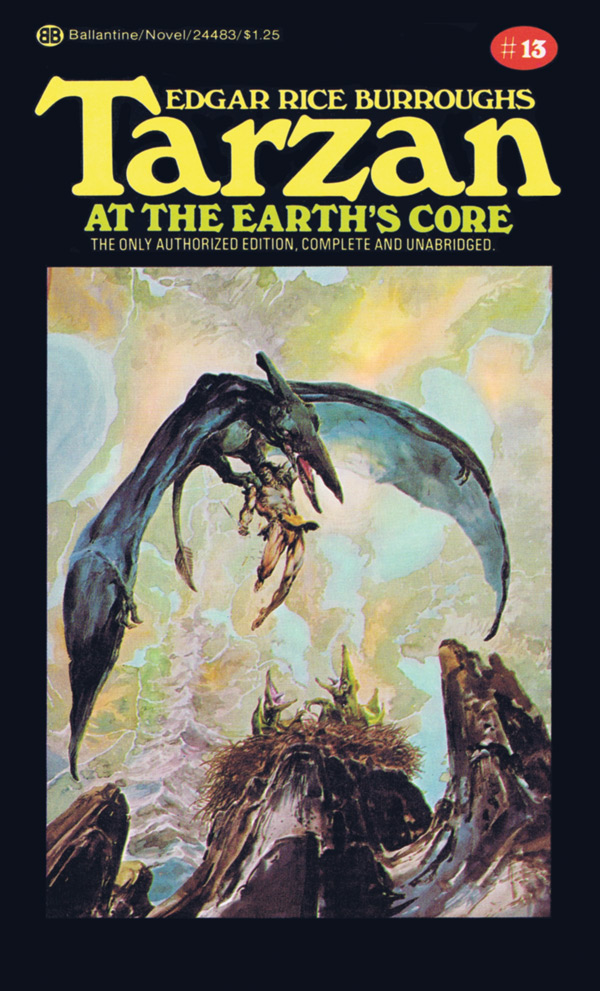 The serial version, with the more exciting title Tarzan at the Earth’s Core, appeared in Blue Book in six installments from September 1929 to March 1930. Metropolitan Newspaper Services (where Burroughs went after separating from McClurg) published the hardcover later in 1930 with a J. Allen St. John cover and frontispiece.
The serial version, with the more exciting title Tarzan at the Earth’s Core, appeared in Blue Book in six installments from September 1929 to March 1930. Metropolitan Newspaper Services (where Burroughs went after separating from McClurg) published the hardcover later in 1930 with a J. Allen St. John cover and frontispiece.
While working on the book, Burroughs received a request from Blue Book’s editor, Edwin Balmer, to draw a map of Pellucidar. Burroughs already had one sketched out and sent it to the magazine, along with five pages of dense information about the novel’s dirigible airship, the O-220 (named after Ed’s telephone number, Owensmouth-220). The notes are an interesting peek into the research ERB used to craft a sense of scientific accuracy in stories that are otherwise closer to science-fantasy.
You may have noticed the stock market crashed during the initial serial publication of Tarzan at the Earth’s Core. If Burroughs thought he wasn’t receiving enough money for his work in 1929…
The Story
A prologue introduces Pellucidar for Tarzan-only readers coming direct from Tarzan and the Lost Empire. Readers arriving from Tanar of Pellucidar already know the cliffhanger: Jason Gridley of Tarzana has discovered via radio wave that David Innes, Emperor of Pellucidar, is a captive in the dungeons of the pirate city of Korsar.
Smash Cut To: John Clayton, Lord Greystoke. While handling the day-to-day management of his jungle domain, Tarzan encounters Jason Gridley on an expedition. Gridley has come seeking Tarzan’s help to rescue David Innes. His plan is to pilot a dirigible airship through the polar entrance to Pellucidar. Tarzan helps with the construction of airship O-220 by bringing a special metal from Central Africa, vibranium Harbenite, allowing for lightweight construction so the O-220 can use vacuum tanks rather than helium or hydrogen. (Just go with it.)
The dirigible takes flight from Germany and navigates to the polar opening, passing into the concave inner world. Tarzan, commander of the expedition, immediately sets out on his own to thrill to this new wilderness. He ends up caught in a snare and a captive of the gorilla people of Pellucidar, the Sagoths. The crew of the O-220 sends out an expedition to find Tarzan, which runs into a disaster when a prehistoric beast stampede scatters them. Gridley makes it back to camp and sets out in a scout plane to locate the now multiple missing people. A Pteranodon knocks his plane from the sky, and now everybody is stranded and lost.
So begins our characters’ multiple journeys in a circular quest to locate each other while battling vicious beasts, savage human tribes, and the reptilian race of the Horibs. Tarzan briefly teams up with a renegade Sagoth, Tar-gash. Then he beats up and kills a lot of things. Jason Gridley falls for lovely Jana, The Red Flower of Zoram, although he immediately turns her off with his prejudices carried over from his civilized Hollywood existence. Tarzan beats up and kills more things.
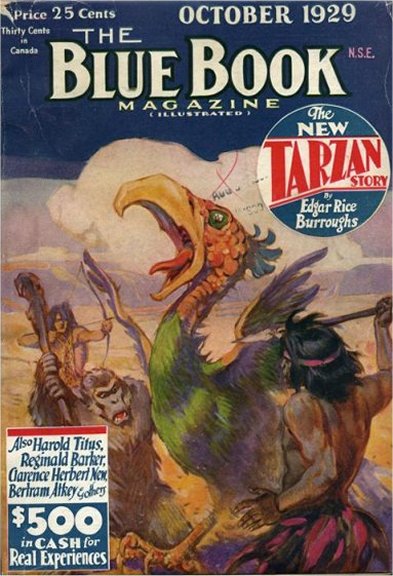 At last the protagonists meet up again, and a joint expedition of the O-220 and the fleet of the Empire of Pellucidar forces the Korsars to surrender David Innes. Everyone’s happy except for von Horst, the poor first mate of the O-220 who was left behind somewhere in pathless Pellucidar.
At last the protagonists meet up again, and a joint expedition of the O-220 and the fleet of the Empire of Pellucidar forces the Korsars to surrender David Innes. Everyone’s happy except for von Horst, the poor first mate of the O-220 who was left behind somewhere in pathless Pellucidar.
There’s also a flying Stegosaurus.
The Positives
Although it suffers from some of the difficulties that made Tanar of Pellucidar a periodic chore, Tarzan at the Earth’s Core powers over the bumps on the road through raw energy and the vitality of its hero. It makes for an exciting read and arguably one of the better novels from Burroughs’s early 1930s output. Tarzan helps Pellucidar, and Pellucidar helps Tarzan. It’s a good wine-and-cheese pairing.
Since Black Gate readers haven’t heard much about my opinion of the literary Tarzan, here’s the short version: Tarzan of the Apes, born John Clayton, Viscount Greystoke, is Edgar Rice Burroughs’s greatest character. The ape-man’s pop culture fame is no fluke. Not only is the original Tarzan of the Apes one of Burroughs’s best novels and as exciting a work as appeared in the early pulps, but its hero continued to draw out the best in ERB as a writer through numerous sequels. Tarzan sometimes appears in dull books, but even late into his literary career the Lord of the Jungle could summon up robust and thought-provoking prose. Tarzan at the Earth’s Core benefits at all points from the title character’s mere presence.
Relative to the Tarzan series, the book is an improvement over its two predecessors, Tarzan, Lord of the Jungle (1927–28) and Tarzan and the Lost Empire (1928–29). The Tarzan novels reached an imaginative peak with Tarzan and the Ant Men in 1924, and then began a long slide into a drab repetition of the ape-man stumbling into lost civilizations, getting amnesia, and dealing with Tarzan impostors. Tarzan at the Earth’s Core is a flourish in an otherwise mediocre phase of Lord Greystoke’s career, putting him in an environment that can hurl weird challenges at him every other chapter.
As soon as Tarzan breaks loose in Pellucidar, there’s new energy to the setting, a different style, an explosion of possibilities and high adventure that feel different from what came before. It’s quite spectacular. The energy suffuses the novel, making for a wild ride that covers up the “get captured/escape” and “pursue/get captured” round-robin that was already mechanical for ERB. The author is in a more inventive mode than usual for the 1930s, so even with the lesser patches and a story driven by chance rather than characters making significant choices, there’s little opportunity for readers to get bored — until the unfortunate final chapter, but we’ll get to that.
Although Burroughs never used the first-person POV to explore Tarzan, the character often expressed himself with an introspection matching his importance in his creator’s canon. When the Sagoths first capture Tarzan, he contemplates why this race’s language has so much in common with that of the apes of Africa who raised him. Tarzan decides they either share a common ancestor or evolution follows a path rigid enough to lead to similar languages. This isn’t an idea the novel explores in depth (seriously, where did the Sagoths come from?), but it adds to Tarzan’s reflective nature.
The most interesting passage for Tarzan concerns his views on religion, something rarely touched on before:
The Lord of the Jungle subscribed to no creed. Tarzan of the Apes was not a church man; yet like the majority of those who have lived close to nature he was, in a sense, intensely religious. His intimate knowledge of the stupendous forces of nature, of her wonders and her miracles had impressed him with the fact that their ultimate origin lay far beyond the conception of the finite mind of man, and thus incalculably remote from the farthest bounds of science. When he thought of God he liked to think of Him primitively, as a personal God. And while he realized he knew nothing of such matters, he liked to believe after death he would live again.
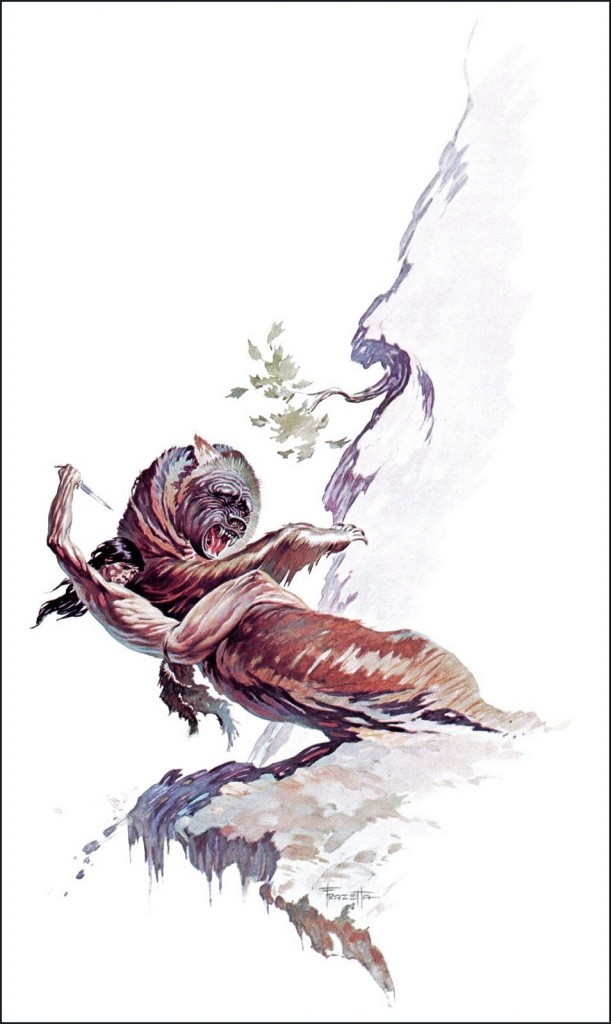 This reads like Burroughs combining his own distaste for organized religion and his vague deism with a gumbo that might be termed “mystical agnostic pantheism.” Theologically or philosophically sound? It doesn’t matter, because it sounds exactly like what Tarzan would believe.
This reads like Burroughs combining his own distaste for organized religion and his vague deism with a gumbo that might be termed “mystical agnostic pantheism.” Theologically or philosophically sound? It doesn’t matter, because it sounds exactly like what Tarzan would believe.
Where Pellucidar provides a boost to Tarzan is the restrictions it puts on some of the hero’s more impressive abilities. The inner world’s stationary sun obliterates Tarzan’s perfect sense of direction that makes it impossible for him to become lost in his African domain. In any other circumstances, I would never buy that Tarzan could become lost in the wilderness. In Pellucidar it makes complete sense. Burroughs doesn’t press this point; it’s something the story and Tarzan quickly accept. The limitations extend to the rest of the O-220 expedition: keeping track of time is impossible, and because compasses don’t work and the sun offers no directional reference, moving out of sight of base camp can mean becoming lost instantly.
Then there’s the cornucopia of Pellucidarian beasts to put Tarzan to the test. We know the ape-man can wrestle lions and pythons and raging apes. But up against a Pterodactyl, a massive cave bear, a terror bird (Phororhacos), sabertooth cats, and reptile men, Tarzan must switch up his tactics. This makes the action scenes fresh. The Pterodactyl sequence is a standout among a book filled with Tarzan action highlights; there are reasons it’s the most illustrated moment from the novel.
Jason Gridley’s half of the story turns a bit sour once the love conflict with Jana begins, but until then his adventures have almost the same excitement as Tarzan’s. When Gridley and a team of Waziri warriors and German officers march into the wilds to search for Tarzan, there’s a sensation like The Land That Time Forgot that’s new to Pellucidar. The expedition moves straight into the book’s most memorable sequence: the tremendous beast stampede that scatters the search party. Burroughs puts his all into crafting this moment, which features a horde of prehistoric life passing in a feverish panorama. There hasn’t been so fantastic a view of the weird fauna of Pellucidar so far in the series, and it’s breathtaking in its madness.
Another top-notch moment for Gridley is his first meeting with Jana as she flees from the men of Pheli trying to kidnap her. This concludes in a three-way battle involving Jason, the Phelians, and a pack of ravenous hyaenodons. Jason draws out the revolvers and blazes away in classic pulp bang-bang style.
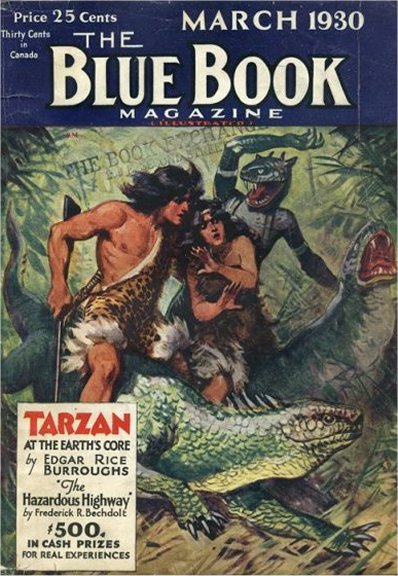 Burroughs also gives Jason Gridley his own opportunities for introspection. Before the romance overwhelms Gridley’s part of the story, he contemplates the existence of Pellucidar and compares it to the surface world in a misanthropic manner different from the views of David Innes. Gridley thinks of the human race as “the Creator’s greatest blunder” and takes the lesson from the evolutionary laboratory of Pellucidar that “within two hundred years… the natural resources of the outer world would have been so depleted that the last generation must either starve to death or turn to cannibalism to prolong its hateful existence for another short period.” Gridley also finds life in Pellucidar is almost as rough as trying to elude death by traffic accident at a busy street corner in Los Angeles. This flavor of straightforward bitterness wouldn’t make sense for Tarzan’s more pantheistic pessimism, but it works for a one-shot hero like Jason Gridley and broadens the way readers see Pellucidar.
Burroughs also gives Jason Gridley his own opportunities for introspection. Before the romance overwhelms Gridley’s part of the story, he contemplates the existence of Pellucidar and compares it to the surface world in a misanthropic manner different from the views of David Innes. Gridley thinks of the human race as “the Creator’s greatest blunder” and takes the lesson from the evolutionary laboratory of Pellucidar that “within two hundred years… the natural resources of the outer world would have been so depleted that the last generation must either starve to death or turn to cannibalism to prolong its hateful existence for another short period.” Gridley also finds life in Pellucidar is almost as rough as trying to elude death by traffic accident at a busy street corner in Los Angeles. This flavor of straightforward bitterness wouldn’t make sense for Tarzan’s more pantheistic pessimism, but it works for a one-shot hero like Jason Gridley and broadens the way readers see Pellucidar.
The Horibs are an excellent villain race, similar in concept to the Coripies from Tanar of Pellucidar but without a sympathetic character — not that they need one. A race that resembles what dinosaurs might have become if they evolved into a sentient tool-using species is conceptually far ahead of its time. Reading about the Horibs swarming down to the riverbanks on the backs of giant therapsids (called Gorobors, but identified scientifically as Paresisauri) is so uniquely Pellucidarian that I’m disappointed Burroughs didn’t invent the race earlier. The Horibs would make great opponents of the Sagoths.
There isn’t an actual framing device in the novel; the prologue is a re-cap of necessary information from the previous book. However, the opening chapters with Jason Gridley locating Tarzan and the construction of the O-220 serve an identical purpose and provide the same enjoyment as a narrative frame. The creation of the O-220 is a wonderful dose of early Steampunk, and Burroughs provides a level of detail about the ship’s design that’s uncommon for him — there’s a wisp of Jules Verne to all this. The giant airship with magical metal is fascinating, and its entrance into Pellucidar through the polar entrance is a magnificent portrait of “Romance with a Capital R.” This is the type of sequence that begs for a contemporary movie treatment.
The expanded wildlife is the largest addition to Pellucidar as a setting, but there are also bits of the mythology of the inner world peppered throughout. We learn how the inhabitants view cosmogony when Thoar of Zoram explains to Tarzan his belief that Pellucidar floats on a flaming sea called the Molop Az, which is inhabited by demons who carry the dead piecemeal from their burial spots into the fiery sea.
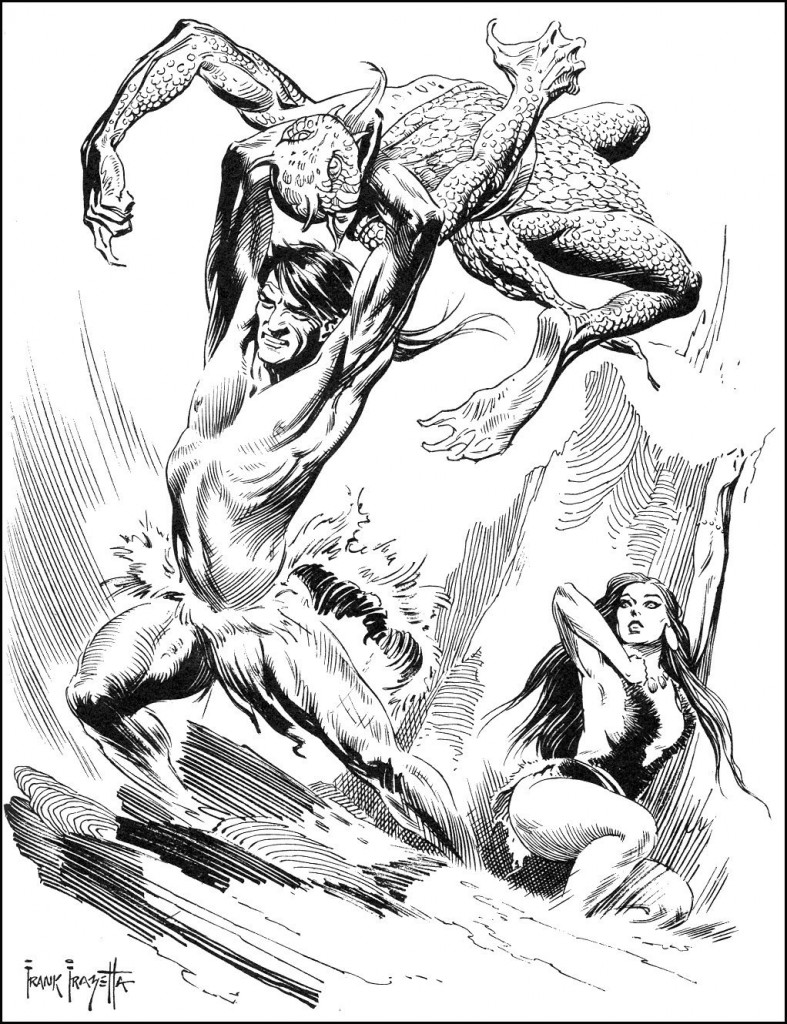 A highlight of the initial meeting between Lord Greystoke and Jason Gridley is that Gridley brings an affidavit from the author who created Tarzan to inform him of the truth of a location the author also created. The meta-universe of ERB is a delightfully tangled place.
A highlight of the initial meeting between Lord Greystoke and Jason Gridley is that Gridley brings an affidavit from the author who created Tarzan to inform him of the truth of a location the author also created. The meta-universe of ERB is a delightfully tangled place.
The Negatives
Poor Emperor David Innes! No one seems to care much about rescuing him. Even though reaching Innes is the goal of two books, the heroes in both never expend real effort trying to track him down. Tarzan at the Earth’s Core starts as an expedition specifically to liberate Innes. But after the O-220 touches down, the original quest vanishes and the story morphs into a survival tale, with Tarzan and Gridley roaming the wildest regions of Pellucidar among bizarre monsters and antagonistic races. By the time Tarzan meets the Clovi tribe in the second half of the book, readers may have forgotten David Innes’s existence. Why not have an adventure story based on fighting through Korsar lands on Innes’s trail instead of resetting to the boilerplate “people lost in hostile lands until they coincidentally find each other again”? It’s good Tarzan brings a new perspective and Burroughs was willing to go for broke on the action and monsters; otherwise this may have turned into a retread of Tanar of Pellucidar.
The action shifts to Korsar only in the final chapter, which serves up a heaping disappointment of an ending. In a tradition in the Pellucidar books of wrapping up everything in a hurry in the last few pages, the rescue of David Innes is accomplished by the heroes simply showing up at Korsar with enough guns. The Cid hands over David Innes and it’s over. Tarzan never swings into action against the Korsars or makes a daring journey into their dungeons — the set-pieces you hoped to see from him. Considering how exciting the rest of the action is, the letdown of this static climax is immense. Tarzan came all this way through tremendous dangers for this? He doesn’t even have a scene with David Innes! That’s like sending Tarzan to Mars but never having him encounter John Carter.
This omission deserves scrutiny. Although Burroughs gets tremendous mileage out of Tarzan in a new world, he skips over an enticing possibility: the Lord of the Jungle confronting the civilizing forces David Innes unleashed on the inner world. In Pellucidar, Innes tamed the land’s savagery with the tools of the modernity. This is an idea that goes against Tarzan’s basic existence. What would Tarzan have thought if he saw the Industrial Revolution Innes forced onto the primitive wilds of Pellucidar? Since the novel keeps Tarzan in the wilderness and doesn’t give him a scene with Innes, we never learn. Jason Gridley does more harping on civilization vs. primitivism than Tarzan — but Gridley doesn’t have a scene with Innes either.
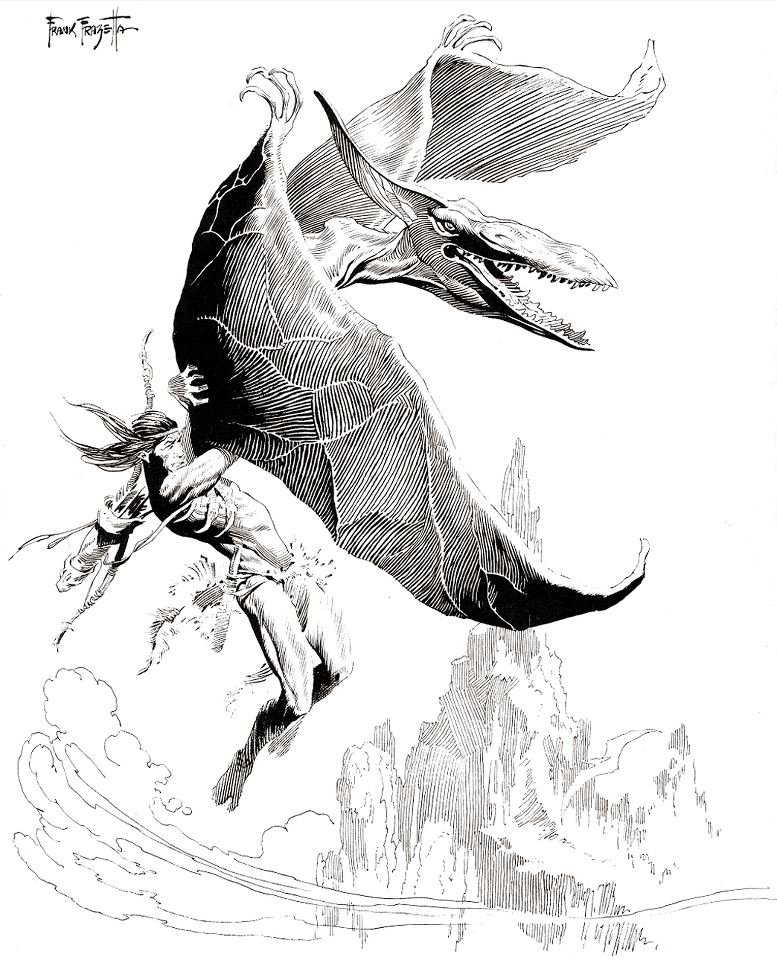 Do we need a love story with doe-eyed Jana instantly falling for Jason Gridley? Couldn’t we skip this for once? No, despite having no need of a romance, one stirs up with a love-at-first-sight cliché between Gridley and Jana. It’s followed immediately with the arbitrary block, which is that Jason outwardly displays to Jana his hesitation because he compares her to the women he knows back in Hollywood. This is an intentionally hilarious passage (partially quoted below), a bit of Burroughs’s life in Southern California telegraphing in. But it’s also jarring and used as an excuse for yet another romantic obstacle with flimsy reasons to exist. Jana could function fine as a heroine without a romance, but Burroughs couldn’t help himself.
Do we need a love story with doe-eyed Jana instantly falling for Jason Gridley? Couldn’t we skip this for once? No, despite having no need of a romance, one stirs up with a love-at-first-sight cliché between Gridley and Jana. It’s followed immediately with the arbitrary block, which is that Jason outwardly displays to Jana his hesitation because he compares her to the women he knows back in Hollywood. This is an intentionally hilarious passage (partially quoted below), a bit of Burroughs’s life in Southern California telegraphing in. But it’s also jarring and used as an excuse for yet another romantic obstacle with flimsy reasons to exist. Jana could function fine as a heroine without a romance, but Burroughs couldn’t help himself.
The romantic subplot makes it easy for readers to start disliking Jason Gridley. To throw another obstacle against his feelings for Jana, Burroughs uses a clumsy contrivance where Gridley mistakenly assumes that Thoar is Jana’s mate rather than her brother — information Thoar simply forgets to provide and which never comes up naturally until the last chapter. This sends Jason into an “all women are liars!” internal monologue. It’s outrageous and makes it hard for readers to root for him. At this point, every time the story cuts back to Tarzan, it improves.
There isn’t anything like a central villain in the novel. The Horibs occupy only the last quarter of the book. The Korsars are barely present, and The Cid never physically appears. Skruk, the Phelian who wants to force Jana to marry him, pops up for a single chapter. Other characters who feel like they may take up bad-guy duties end up only mileposts along the plot road. The story doesn’t really need a major antagonist because it follows the heroes from one set of captors to the other. But I miss that special kind of ERB “vile sneak” baddie to help tie together events. Having the Korsars at least enter the story earlier would’ve made for a smoother series of events.
The absence of the village of Pheli is strange, since it seems as if these enemies of Zoram are designed to play a significant role. But our heroes never even reach Pheli. Just as they are about to enter the village, the Korsars seize them, and Pheli ends up having zero impact on events.
The constant capture of the heroes by one group or the other is only annoying in the Big Picture sense, but it’s hard to avoid thinking about it as the book starts to come to a close and it continues to happen.
Craziest Bit of Burroughsian Writing: “[Jason Gridley] saw, too, the aristocratic features of Barbara Green, daughter of Old John Green, the Los Angeles realtor, from Texas. It is true that Old John was no purist and that his total disregard of the social precedence of forks often shocked the finer sensibilities that Mrs. Green and Barbara had laboriously achieved in the universities of Montmartre and Coconut Grove, but Barbara had two years at Marlborough and knew her suffixes and her hardware.” Uhm, Ed, can we get back to the prehistoric land at the center of the Earth?
Most Inventive Idea: Piloting a dirigible made of ultralight metal through a polar entrance to the inner world. In conception and execution it’s marvelous.
Best Creature: The dyor, a Stegosaurus that can glide through the air by flattening its backplates. This isn’t entirely Burroughs’s whacked-out creation: Dr. W. H. Ballou floated the idea in a Utah newspaper article in 1920. Burroughs clipped unusual news stories for ideas, and he probably pulled this from his dinosaur file one day and went with it.
Carson Napier Pre-Memorial Foolishness Award: Tarzan doesn’t make foolish mistakes. How dare you even suggest it.
Just curious: Does Tarzan find out that Jason Gridley lives in a town called “Tarzana”? And that the town is named after him? That would lead to an awkward conversation.
How about a sequel? The door is open to one, since Jason Gridley elects to remain in Pellucidar to search for von Horst, the only member of the expedition still missing. But that doesn’t sound terribly interesting. I’d prefer another crossover. Why not send Tarzan to Caspak? Burroughs could give the ape-man amnesia (again) and call the book The Land That Tarzan Forgot!
Next: I’m going to take a brief mid-series break to look at Burroughs’s 1913 novel The Monster Men. Then it’s back to Pellucidar for Back to the Stone Age.
Ryan Harvey is one of the original bloggers for Black Gate, starting in 2008. He received the Writers of the Future Award for his short story “An Acolyte of Black Spires,” and his stories “The Sorrowless Thief” and “Stand at Dubun-Geb” are available in Black Gate online fiction. A further Ahn-Tarqa adventure, “Farewell to Tyrn”, is currently available as an e-book. Ryan lives in Costa Mesa, California where he works as a professional writer for a marketing company. Occasionally, people ask him to talk about Edgar Rice Burroughs or Godzilla in interviews.
TOTALLY looking forward to the “Monster Men” review. One of those novels that ERB could’ve fleshed out a little more. The titular monsters always had a poignant quality to me. By the way, “Sing Lee” would seem to be the same person as “Sing” in THE RETURN OF THE MUCKER.
I like this one. One of my favorite moments is when, shortly after decamping in Pellucidar, the great Tarzan of the Apes himself realizes that he is freakin LOST.
@Thomas – Yeah, Pellucidar is fun that way.
Back in the old days, when my Tarzan reading was limited to what I could find (mostly black-covered Ballantine paperbacks) on the public library spinners, Earth’s Core was something of a white whale — I knew it existed, but could never lay a hand on it. (Also, I don’t recall if I had access to any Pellucidar books at that point.)
When, several years later, I did manage to lay hands on a copy, I was happy to find it just as good as I had hoped.
Tarzan is at the Earth’s Core is extended tour Pellucidar’s megafauna and it is awesome!